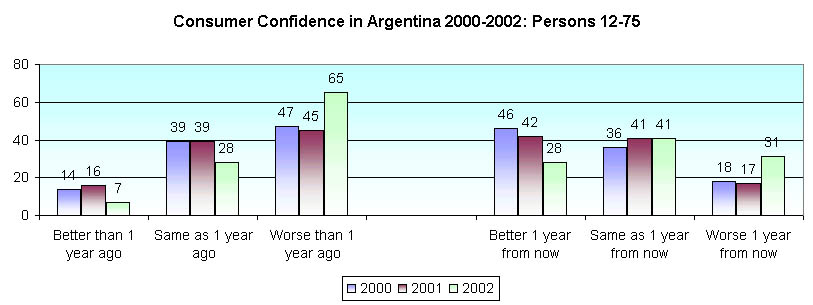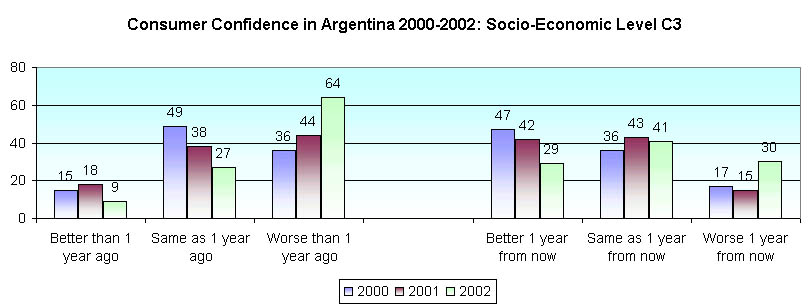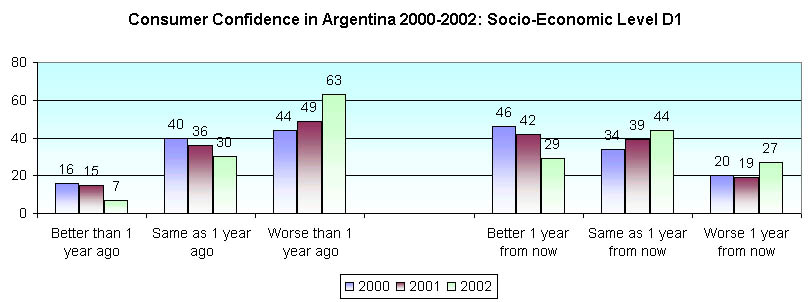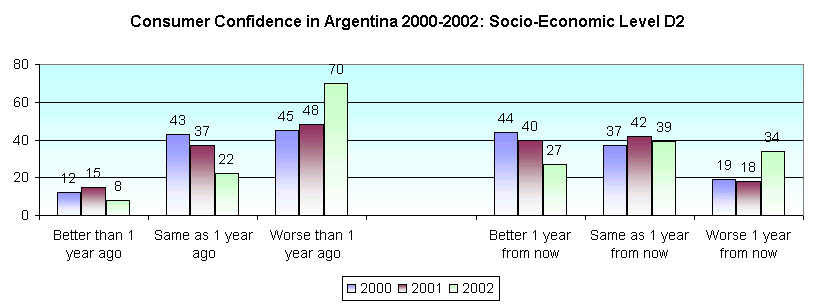
Consumer Confidence in Argentina: 2000-2002
For about four to five years, an economic recession had been going on in Argentina, with unemployment holding steady at around 20%. At the end of 2001, the full political crisis blew up, during which there were five different presidents in Argentina in a brief period of just 13 days. Even with the consensus candidate of national salvation Eduardo Dualde in place, it was still by no means clear that the end is in sight. Instead, Argentina looked like a former second-world country with third-world problems such as malnutrition and starvation.
The current crisis is visible as a political crisis, but the underlying dynamics is an economic crisis. At risk was the possibility of the total collapse of the banking system. The Argentine peso used to be pegged at a one-to-one exchange rate against the US dollar. When the US dollar was strong, Argentine goods became too expensive to export to other countries. When a devaluation appeared imminent, everyone obviously wanted to withdraw their peso deposits and convert them into dollars, for which the banks do not have adequate reserves to oblige. The stopgap solution was to freeze all bank accounts, permitting only small sums to be withdrawn each month. Whilst this action staved off the stampede at the banks, it also had the effect of curtailing spending and the reduced demand leaves to more job losses and economic contraction. This is a rapid downward spiral path.
We will now cite some survey data from the TGI Argentina study. This study was conducted annually. In 2000, 11,890 persons were interviewed. In 2001, 5,946 persons were interviewed. In 2002, 5,063 persons were interviewed. In all three years, the survey respondents were persons between the ages of 12 to 75 years old. In each year, the same questions about consumer confidence were asked about the economic situation of the respondents and their families compared to one year ago, as well as their likely economic situations one year from now. These retrospective and prospective consumer confidence questions are used in many countries around the world (see example).
In the chart below, we show the answers to the consumer confidence questions for 2000, 2001 and 2002. Whereas 2000 and 2001 are still reasonably close, there was a marked deterioration in consumer confidence in the year 2002. Only 7% claimed that they were better off than one year ago, and those who are now worse off jumped from middle 40%'s by 20 percentage points to 65%.
Consumer pessimism also rose as the 14% fewer (from 42% to 28%) believe that they will be better off in one year's time, 14% more (from 17% to 31%) believe that they will be even worse off, and 41% believe that they will be in the same state (which is bad since most of them have said that they are worse off now than before).

In a previous article, we had examined the impact of the recession in Argentina on different socio-economic groups. For the 2001 TGI Argentina survey, we were able to show that economic deterioration was deeper among the lower socio-economic groups, which was doubly painful since they were the most vulnerable. The series of charts below shows the consumer confidence responses by socio-economic level over the three years 2001-2002. Put in this historical context, the current situation is a great equalizer, with all socio-economic groups being negatively impacted ('worse than one year ago' in 2002 ranged from 62% to 70%, and 'worse one year from now' from 27% to 34% ). But, of course, having an equitable distribution of economic woes does not lessen the pain.





(posted by Roland Soong, 7/04/2002)
(Return to Zona Latina's Home Page)